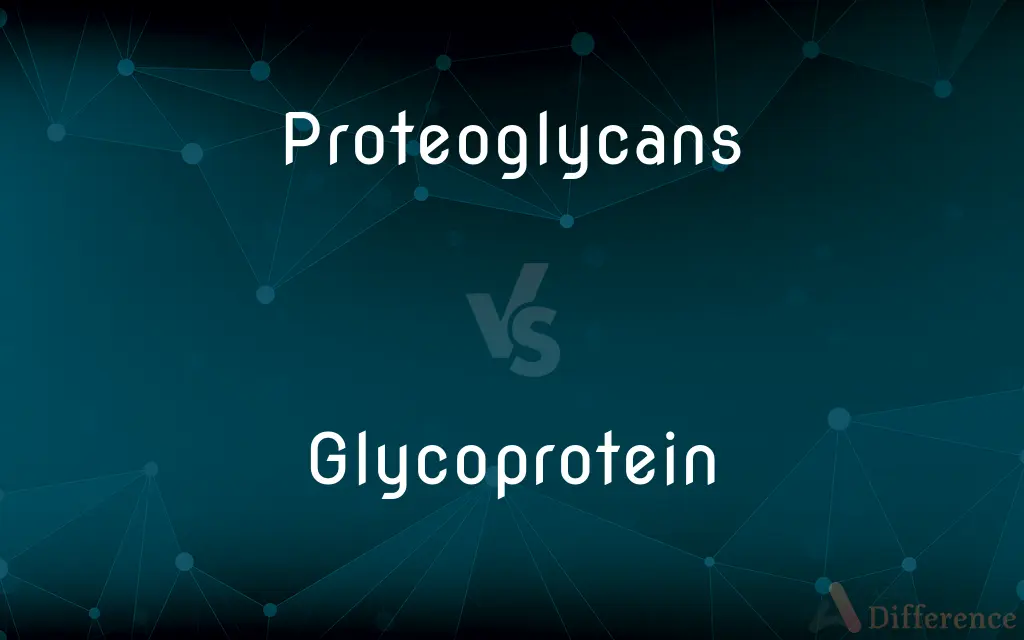Proteoglycans vs. Glycoprotein — What's the Difference?
By Maham Liaqat & Urooj Arif — Updated on April 3, 2024
Proteoglycans are primarily carbohydrate with a core protein, essential in cellular support, while glycoproteins are proteins with carbohydrate chains, playing key roles in cell recognition.

Difference Between Proteoglycans and Glycoprotein
Table of Contents
ADVERTISEMENT
Key Differences
Proteoglycans consist mainly of carbohydrate chains called glycosaminoglycans (GAGs) attached to a core protein, forming large complexes that contribute to the structure and function of the extracellular matrix. They are vital for providing cellular support and in the regulation of cell proliferation. On the other hand, glycoproteins have shorter carbohydrate chains covalently bonded to proteins, and they play critical roles in cell-cell recognition, signaling, and immune responses.
The carbohydrate content in proteoglycans is significantly higher than in glycoproteins, making them heavily glycosylated molecules. This high carbohydrate content affects their physical properties, such as high viscosity and the ability to fill space and resist compressive forces in tissues like cartilage. Whereas glycoproteins, with their lesser carbohydrate content, are more versatile and function in a wide range of biological processes including hormone reception and enzymatic functions.
Proteoglycans are predominantly found in the extracellular matrix (ECM) of connective tissues, where they contribute to the ECM's structure and integrity. They can bind with water to form a gel-like substance that provides cushioning and resistance to compressive forces. Glycoproteins, however, are found both within the cell membrane and in the extracellular environment, serving as enzymes, hormones, and antibodies, among other roles.
The synthesis of proteoglycans involves the addition of GAG chains to a core protein, a process that occurs in the Golgi apparatus. This results in molecules that can be extremely large and complex. Glycoproteins are synthesized through a process called glycosylation, where carbohydrates are attached to specific amino acid side chains on the protein, a modification that can occur both in the endoplasmic reticulum and the Golgi apparatus.
One of the key functions of proteoglycans in the body includes regulating the movement of molecules through the matrix, influencing cell growth and wound healing. Glycoproteins, on the other hand, are involved in almost every aspect of the cell's life, including cell adhesion, signaling, and immune recognition, highlighting their role in maintaining the body's health and response to pathogens.
ADVERTISEMENT
Comparison Chart
Main Components
Mainly carbohydrate chains (GAGs) attached to a core protein.
Proteins with covalently bonded shorter carbohydrate chains.
Function
Support cellular structure, regulate cell proliferation.
Cell-cell recognition, signaling, immune response.
Location
Extracellular matrix of connective tissues.
Cell membrane and extracellular environment.
Carbohydrate Content
Significantly higher, affecting physical properties like viscosity.
Lower, leading to a wide range of biological functions.
Biological Process
Contribute to ECM structure and integrity, bind water for cushioning.
Serve as enzymes, hormones, antibodies, etc.
Compare with Definitions
Proteoglycans
Major component of the extracellular matrix, providing structural support.
The extracellular matrix's integrity is maintained by proteoglycans.
Glycoprotein
Key in cell signaling and the regulation of cell growth.
Glycoprotein receptors bind to specific ligands, initiating signaling pathways.
Proteoglycans
Play a role in the regulation of collagen fibril assembly and diameter.
Collagen fibrils interact with proteoglycans to form structured networks.
Glycoprotein
Involved in numerous physiological processes, including immune responses.
Antibodies are glycoproteins that play a key role in immune defense.
Proteoglycans
Influence the movement of molecules within the extracellular matrix.
The dense network of proteoglycans can regulate molecule permeability in tissues.
Glycoprotein
Serve as enzymes, hormones, and structural components of cells.
Enzymatic glycoproteins catalyze reactions critical to metabolism.
Proteoglycans
Large molecules consisting of a core protein and glycosaminoglycan (GAG) chains.
Proteoglycans in cartilage help it retain water and resist compression.
Glycoprotein
Proteins that have oligosaccharides covalently attached to amino acid side-chains.
Glycoproteins on the cell surface mediate cell-cell recognition.
Proteoglycans
Involved in regulating cellular processes through interaction with growth factors.
Proteoglycans can bind growth factors, influencing cell proliferation.
Glycoprotein
Function as transport molecules and blood clotting factors.
Some glycoproteins transport substances across the cell membrane.
Proteoglycans
Plural of proteoglycan
Glycoprotein
Glycoproteins are proteins which contain oligosaccharide chains (glycans) covalently attached to amino acid side-chains. The carbohydrate is attached to the protein in a cotranslational or posttranslational modification.
Glycoprotein
Any of a class of proteins which have carbohydrate groups attached to the polypeptide chain.
Glycoprotein
Any of a group of conjugated proteins having a carbohydrate as the nonprotein component.
Glycoprotein
(protein) A protein with covalently bonded carbohydrates.
Glycoprotein
A conjugated protein having a carbohydrate component
Common Curiosities
What is the main function of proteoglycans?
They provide structural support and regulate cell proliferation and movement.
What roles do glycoproteins play in the body?
They are involved in cell-cell recognition, signaling, immune responses, and serve as enzymes and hormones.
What are proteoglycans?
Large molecules in the extracellular matrix composed of a core protein and glycosaminoglycan chains.
Can proteoglycans affect cell behavior?
Yes, by interacting with growth factors and other molecules, they can influence cell growth and differentiation.
How do proteoglycans contribute to tissue hydration?
They bind water, creating a gel-like substance that provides cushioning and resistance to compressive forces.
Where are proteoglycans found?
Mainly in the extracellular matrix of connective tissues.
Can glycoproteins act as hormones?
Yes, some hormones are glycoproteins, playing roles in signaling pathways that regulate physiological functions.
What is the significance of glycoproteins in cell signaling?
They function as receptors on cell surfaces, initiating cellular responses to external signals.
What are glycoproteins?
Proteins with covalently attached oligosaccharides.
How are glycoproteins involved in immunity?
As antibodies, they identify and neutralize foreign objects like bacteria and viruses.
Share Your Discovery

Previous Comparison
Heard vs. Herd
Next Comparison
Miss vs. MissesAuthor Spotlight
Written by
Maham LiaqatCo-written by
Urooj ArifUrooj is a skilled content writer at Ask Difference, known for her exceptional ability to simplify complex topics into engaging and informative content. With a passion for research and a flair for clear, concise writing, she consistently delivers articles that resonate with our diverse audience.















































